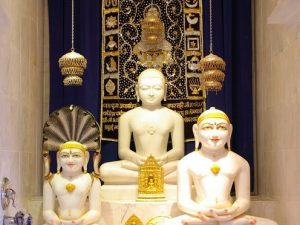
The Jain Mahamantra is Namokar Mantra:
Namo Arihantanam (I bow in reverence to Arihanta)
Namo Siddhanam (I bow in reverence to Siddhas)
Namo Ayariyanam (I bow in reverence to Acharayas)
Namo Uvajjhayanam (I bow in reverence to Upadhyayas)
Namo Loye Savva Sahunam (I vow in reverence to all Sadhus)
Eso Panch Namoyaro (this five fold salutation)
Savva Pavappanasano (destroys all sins)
Mangalanam Cha Savvesim (and amongst all suspicious things)
Padhamam Havi Mangalam (is the most auspicious one)
Since time infinite, during every fourth period of the time cycle there are 24 Tirthankars (path finder or prophet) who achieve Omniscience. The Divine Murthis of Tirthankars Bhagwan Adinathji / Rishabhdevji, Bhagwan Parshwanathji, and Bhagwan Mahavir Swamiji have established in the sanctorum at the temple, to represent the current Tirthankars in the fifth period of this era. The word “Tirthankar” signifies a teacher who revives the sacred principles of Jainism after achieving omniscience through total elimination of Karma. A Tirthankar is also called a Veet-raag meaning who is free from worldly attachments. Bhagwan Adinathji is the first Tirthankar of the Jain religion. Bhagwan Parshvanathji is the 23rd and Bhagwan Mahavir Swamiji is the 24th – the last Tirthankar.
At the Temple, Jain’s practice six essentials of Sadhana in our daily life. These include Samayik (stay close to the soul – develop and practice equanimity), Stuti (do Logassa atleast 3 times – prayer of 24 Tirthankaras), Vandana (recite Namokar Mantra at least 3 times), Pratikraman (ask forgiveness), Pratyakhyan (take vows and not to do the same wrong thing again) and Kayotsarga (do meditation). Puja of Tirthankardev is the first amongst the six essentials for doing ‘Upasana’. The remaining five are Guru Upasana, Swadhyaya, Sanyam (to control mind, and five senses), Austerity (tap), and Daan (giving to needy). Additionally, through various rituals that are designed by Acharyas, Jain devotees try to understand the messages of God, practice proper conduct in life, and attempt to tap into their personal Shudhatma, which is the ocean of bliss and thereby ultimately achieving liberation.
Once a month we perform Snatra Puja written by Shri Virvijayji Maharaj. We remember various Tirthankars and pray for the peace and happiness of the whole universe. During the puja, we place a small brass or bronze murti of Tirthankar Bhagwan on the Sinhasan (throne) on top of three tables. Three tables and the Sinhasan symbolize the Samovsaran where Tirthankaras delivered sermons after attaining Kevalgyan, This also symbolizes the Meru Parvat where Inder Maharaj celebrates the birth of Bhagwan Mahavir Swamiji.
Devotees are encouraged to participate in performing the puja by wearing clean clothes, put on Kesar Tilak and tie a dnad Chhadee (red string) on their wrists. Murtis are bathed with Panchamrit water which contains 1) clean water 2) Dahee (yogurt) 3) Sugar or honey 4) ghee 5) kesar. After the bath (Prakshal), this same water is used for Shanti Kalash Puja which is the last part of the Snatra Puja.
Snatra Puja is done in four parts:
1) Offering Kusumanjali: consists of water, rice, flowers and kesar. This is done to remove sins and bad karmas to become Siddhas.
2) Re-enacting Bhagwan Mahavir Swami Ji’s Janam Mahotsav (birth). Items used are: Coins, mirror, pearls, jewels, fans, chamars, rakhi, bell and a bull shaped kalash
3) Ashta-prakari puja is done by these eight items: water, kesar flowers, dhoop, deepak, rice, sweets, and fruits.
4) Shanti Kalash and Chaitya Vandan: During this year, we pour water (Panchamrit from Prakashal) in a silver pot while reciting Shanti Mantras. Now, this holy water is considered to have special powers to bring peace and happiness and remove obstacles in one’s life. Devotees are supposed to bless themselves with this water. Wherever this water is sprinkled, that place becomes blessed.
Once a year, we celebrate Mahavir Jayanthi (Birth of Lord Mahavir Swami Ji) in the month of April, Paryaushan Prava and 14 dreams of Trishala Mata (Bhagwan Mahavir Swami Ji’s Mother) in the month of August or September, and 18 Abhishek to commemorate the Pran Prathista of Murtis at our Temple in the month of November.
.

